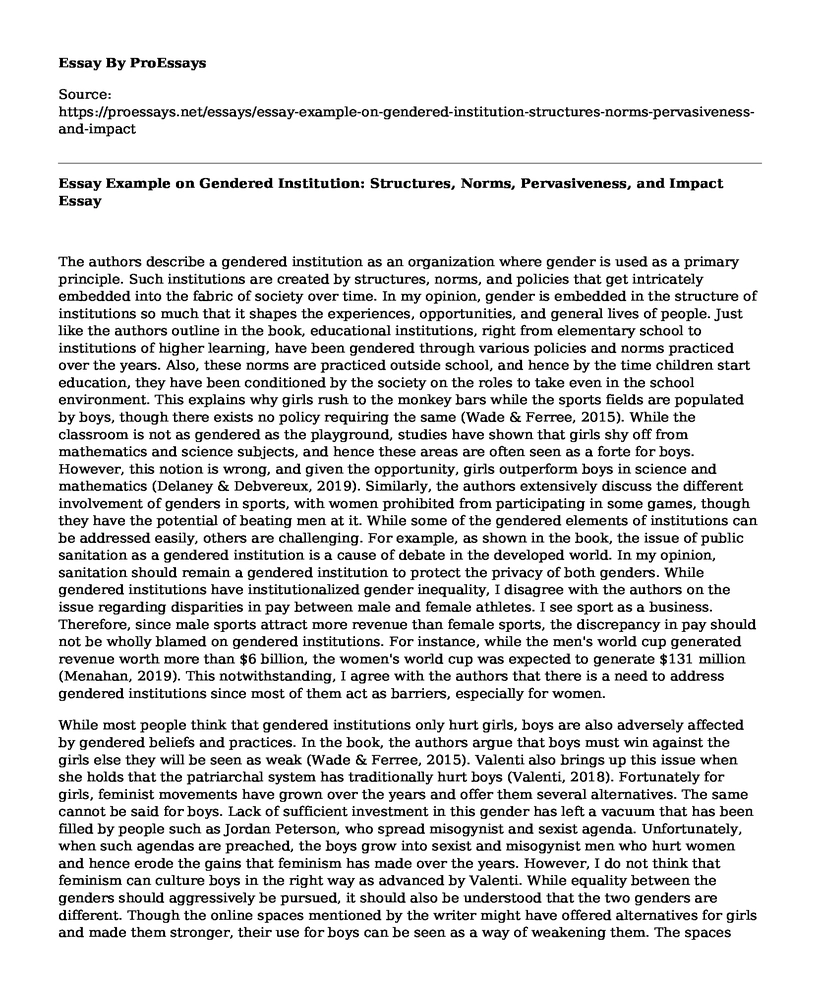The authors describe a gendered institution as an organization where gender is used as a primary principle. Such institutions are created by structures, norms, and policies that get intricately embedded into the fabric of society over time. In my opinion, gender is embedded in the structure of institutions so much that it shapes the experiences, opportunities, and general lives of people. Just like the authors outline in the book, educational institutions, right from elementary school to institutions of higher learning, have been gendered through various policies and norms practiced over the years. Also, these norms are practiced outside school, and hence by the time children start education, they have been conditioned by the society on the roles to take even in the school environment. This explains why girls rush to the monkey bars while the sports fields are populated by boys, though there exists no policy requiring the same (Wade & Ferree, 2015). While the classroom is not as gendered as the playground, studies have shown that girls shy off from mathematics and science subjects, and hence these areas are often seen as a forte for boys. However, this notion is wrong, and given the opportunity, girls outperform boys in science and mathematics (Delaney & Debvereux, 2019). Similarly, the authors extensively discuss the different involvement of genders in sports, with women prohibited from participating in some games, though they have the potential of beating men at it. While some of the gendered elements of institutions can be addressed easily, others are challenging. For example, as shown in the book, the issue of public sanitation as a gendered institution is a cause of debate in the developed world. In my opinion, sanitation should remain a gendered institution to protect the privacy of both genders. While gendered institutions have institutionalized gender inequality, I disagree with the authors on the issue regarding disparities in pay between male and female athletes. I see sport as a business. Therefore, since male sports attract more revenue than female sports, the discrepancy in pay should not be wholly blamed on gendered institutions. For instance, while the men's world cup generated revenue worth more than $6 billion, the women's world cup was expected to generate $131 million (Menahan, 2019). This notwithstanding, I agree with the authors that there is a need to address gendered institutions since most of them act as barriers, especially for women.
While most people think that gendered institutions only hurt girls, boys are also adversely affected by gendered beliefs and practices. In the book, the authors argue that boys must win against the girls else they will be seen as weak (Wade & Ferree, 2015). Valenti also brings up this issue when she holds that the patriarchal system has traditionally hurt boys (Valenti, 2018). Fortunately for girls, feminist movements have grown over the years and offer them several alternatives. The same cannot be said for boys. Lack of sufficient investment in this gender has left a vacuum that has been filled by people such as Jordan Peterson, who spread misogynist and sexist agenda. Unfortunately, when such agendas are preached, the boys grow into sexist and misogynist men who hurt women and hence erode the gains that feminism has made over the years. However, I do not think that feminism can culture boys in the right way as advanced by Valenti. While equality between the genders should aggressively be pursued, it should also be understood that the two genders are different. Though the online spaces mentioned by the writer might have offered alternatives for girls and made them stronger, their use for boys can be seen as a way of weakening them. The spaces might also lead to stigmatization, as mentioned in the article. Therefore, to address the void left, all institutions must be involved. Right from a young age, boys must be taught to respect all genders and that losing does not mean they are weak. Besides, as mentioned in the book, the development of sports and programs where competition is based on one's talent and competence instead of gender can help deconstruct gendered beliefs in the society (Wade & Ferree, 2015). In such teams, boys and girls will see each other as equals and appreciate the contribution made by each member. With time, the structure of various institutions in society will change, and people such as Peterson will no longer have an audience to exploit.
References
Delaney, J. M., & Debvereux, P. J. (2019). Understanding gender differences in STEM: Evidence from college applications. Economics of Education Review, 72, 219-238. Retrieved from https://www.sciencedirect.com/science/article/pii/S0272775719301761
Menahan, C. (2019, July 8). Men's world cup in Russia made $6B revenue, women's expected to earn $131M in 4-yr cycle. Retrieved from Information Liberation: https://www.informationliberation.com/?id=60459
Valenti, J. (2018, July 25). What Feminists can do for boys. Retrieved from New York Times: https://www.nytimes.com/2018/07/25/opinion/feminists-misogyny-patriarchy.html
Wade, L., & Ferree, M. M. (2015). Gender: Ideas, Interactions, Institutions. W. W. Norton & Company.
Cite this page
Essay Example on Gendered Institution: Structures, Norms, Pervasiveness, and Impact. (2023, May 30). Retrieved from https://proessays.net/essays/essay-example-on-gendered-institution-structures-norms-pervasiveness-and-impact
If you are the original author of this essay and no longer wish to have it published on the ProEssays website, please click below to request its removal:
- Rhetorical Ad Analysis: Linguistic Sexism Paper Example
- Annotated Bibliography on Social Networking on Society
- Essay Example on the Magnetic Power of Jay: How He Easily Wooed Ladies
- 3 Million Denied Firearms: Private Sellers Exempt From Background Checks - Research Paper
- Paper Example on Project C: Affordable Housing for Local Community's Young Families
- Paper Sample on Northwestern Memorial Hospital: Improving Handoff Communication for Better Patient Care
- Essay on Nurturing Emotional Resilience: A Parent's Guide to Addressing and Preventing Drug Abuse in Youth







